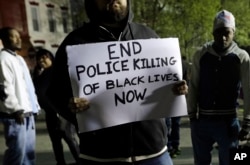The U.S. Department of Justice says the police department in the eastern city of Baltimore, Maryland, violated the Constitution and federal anti-discrimination laws by systemically engaging in a pattern of illegal stops, searches, arrests and use of excessive force, particularly against the city's African-American population.
"Public trust is critical to effective policing and public safety," Attorney General Loretta Lynch said Wednesday. "The results of our investigation raise serious concerns, and in the days ahead, the Department of Justice will continue working tirelessly to ensure that all Baltimoreans enjoy the safety, security and dignity they expect and deserve."
The report found that the Baltimore Police Department's practices perpetuate many issues rooted in poverty and race, focusing law enforcement actions on low-income minority communities in ways that are often unnecessary and unproductive.
WATCH: Baltimore mayor reacts to report findings
"The findings are challenging to hear, but let me be clear, I never sugarcoat our problems, nor will I run away from our most pressing challenges," Baltimore Mayor Stephanie Rawlings-Blake told reporters Wednesday at a news conference there. "The report identifies specific problems in the department, but the transparency of the report offers a crucial foundation if we are going to move forward."
Baltimore Police Department Commissioner Kevin Davis said the report "is not an indictment" of all Baltimore police officers, many of whom he said are "offended" by the details in the report. "This report is, however, an indictment on those bad behaviors by a relatively small number of police officers over many years."
Extensive investigation
Federal investigators interviewed current and former city leaders, police department chiefs and officers, and people and organizations from the community. They also rode along with police officers during their shifts and reviewed hundreds of thousands of pages of documents.
Deputy Assistant Attorney General Vanita Gupta said that nearly everyone investigators interacted with "agreed that the Baltimore Police Department needs sustainable reform."
Gupta said the Baltimore Police Department has agreed with the Department of Justice to negotiate reforms to policies that have led to discriminatory policing.
Samuel Walker, professor emeritus at the University of Nebraska and an expert on police accountability, described the report's findings as "very powerful and very hard hitting." He told VOA the findings represent "a failure of accountability across the board," but he is "guardedly optimistic" the negotiations will lead to an improved police department in Baltimore.
"It will require a number of reforms, changes in their policy on use of force, changes in their policy and training on stops and frisk, and the development of new procedures for reporting use of force," Walker said.
The Justice Department report was launched after the high-profile death of Freddie Gray, a 25-year-old African-American man who died from spinal injuries suffered while he was in police custody. Gray's death fueled ongoing concerns about policing in Baltimore, a city of 620,000 that experienced a record number of homicides last year.
Longstanding issues
The report pointed to the lingering legacy of department policy in the 1990s and early 2000s that prioritized officers making large numbers of stops, searches and arrests, saying that today supervisors who began their careers during that era still focus on those numbers to measure performance.
Investigators found that multiple officers showed a mistaken understanding of the law, believing that people standing in front of a business or a vacant lot were considered to be loitering or trespassing.
In one incident reviewed by the Justice Department team, an officer who believed his supervisor would be unhappy if he did not clear an area where people were talking and waiting for food outside of a late-night restaurant confronted the group and ended up in an altercation with a man who refused to leave. The officer feared the man was going to kick him and responded by firing his gun, striking two people, including one person who was not involved. Supervisors said later the officer acted appropriately.
The report criticized the department for underreporting the number of people that officers stop; but, among the 300,000 reported stops of pedestrians between January 2010 and May 2015, 44 percent took place in two small districts that contain just 11 percent of the city's population and are predominantly African-American.
The Justice Department said the stops "often lack reasonable suspicion," and that less than 4 percent of them resulted in any citation or arrest. Many of those arrested later had their charges dismissed. The report noted that one African-American man in his mid-50s was stopped 30 times in less than four years. None of the 30 stops resulted in a citation or criminal charge.
Targeting African-Americans
"In some cases, BPD supervisors have ordered officers to specifically target African-Americans for stops and arrests," the report said. "BPD failed to use adequate policy, training, and accountability mechanisms to prevent discrimination, despite longstanding notice of concerns about how it polices African-American communities in the city."
The report further criticized the department for using what it says are overly aggressive tactics that only escalate situations.
"Officers frequently resort to physical force when a subject does not immediately respond to verbal commands, even where the subject poses no imminent threat to the officer or others," according to the report.
The Justice Department said nearly 90 percent of excessive force incidents it identified involved force against African-Americans; but, it said the department rarely categorized incidents as excessive.
The Justice Department said it recognizes the challenges officers in Baltimore and other communities face, and said the department's current leadership has taken "laudable steps" toward improvements. Those include revising policies on the use of force, as well as boosting accountability and transparency with steps such as beginning to equip officers with body cameras to record their activities.














